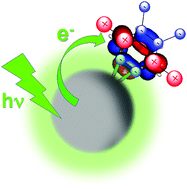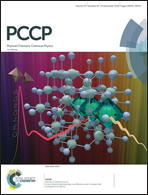Charge transfer at the nanoscale and the role of the out-of-plane vibrations in the selection rules of surface-enhanced Raman scattering†
Abstract
Surface-enhanced Raman scattering (SERS) spectroscopy of pyridazine shows the selective enhancement of the bands recorded at about 1570, 1450 and 380 cm−1, which are assigned to two different types of vibrations. The first two correspond to in-plane 8a;νring and 19b;δ(CH) totally symmetric A1 modes, respectively, while the last band is assigned to the out-of-plane 16b;τring,B1 vibration. The selective enhancement has been analyzed on the basis of a resonant Raman process involving photoexcited metal (M)-to-molecule (A) charge transfer (CT: M–A + hν → M+–A−) states of the metal–adsorbate surface complex, which have also been related to the doublet electronic states of the corresponding radical anion of the adsorbate (A−). According to the selection rules of the electromagnetic/plasmonic SERS enhancement mechanism, the simultaneous enhancement of in-plane and out-of-plane modes could be attributed to different orientations of the adsorbate (perpendicular and parallel, respectively, or tilted) with respect to the metallic surface. The calculated resonance Raman-CT spectra (SERS-CT) and the vibrational wavenumbers of isolated pyridazine and of the pyridazine–Ag2 complex obtained from electronic structure calculations suggest a single type of molecule adsorbed with perpendicular orientation. The relative SERS enhancements of both in-plane and out-of-plane modes are due to Franck–Condon factors related to differences between the equilibrium geometries (A1 vibrations, ΔQ ≠ 0) and gradients (B1 vibrations, Δν ≠ 0 and ΔQ ≠ 0), respectively, of the potential energy surfaces of the involved ground and photoinduced CT electronic states. Therefore, the selective enhancement of the SERS bands of pyridazine is controlled by a general metal-to-molecule resonant CT mechanism. This conclusion supports the usefulness of SERS in studying the subtle electronic structure of charged interfaces as well as key processes such as electron transfer at the nanoscale.



 Please wait while we load your content...
Please wait while we load your content...